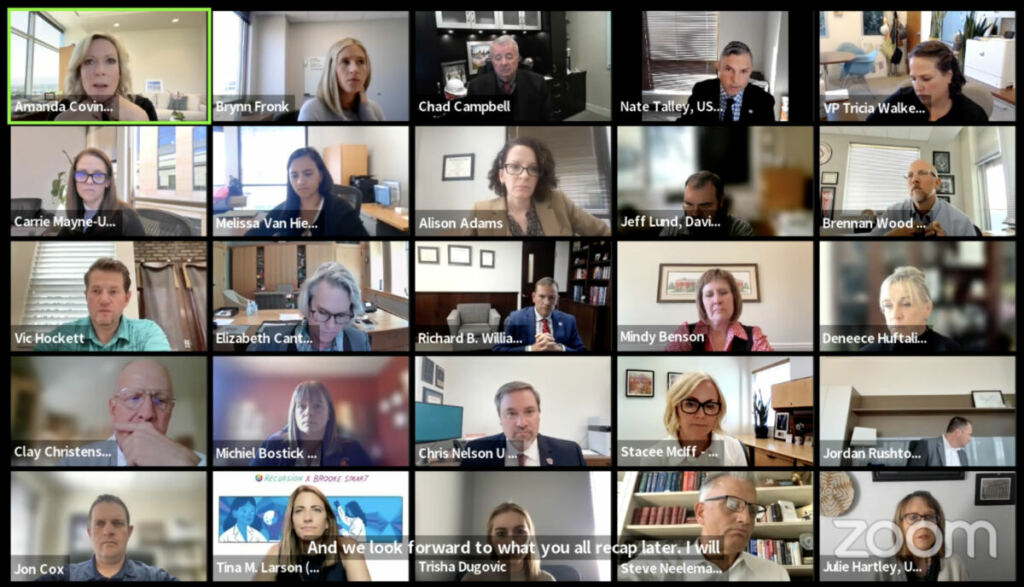The Utah Board of Higher Education convened virtually on Friday, Sept. 8, 2023, for a productive discussion with presidents and other representatives of Utah System of Higher Education institutions on critical issues and opportunities for the future of higher education in the state.
Chair Amanda Covington began the meeting by saying that the Board wants to partner with System presidents and that it wants to move in the same direction to serve our state workforce and our students. She also announced that the Board established its executive committee members, including herself, Vice Chair Steve Neeleman and Board member Javier Chavez Jr.
Several themes arose during the meeting, including the following:
- Three-year bachelor’s degree: One of the first discussion items was the possibility of implementing 90-credit or three-year bachelor’s degree programs within USHE institutions. This initiative was brought up in response to the recent accreditation of such programs in private for-profit institutions.
- System alignment: There was an emphasis on collectively moving forward on various initiatives to improve higher education in Utah. Instead of imposing directives from the top down, there was a discussion on promoting open communication channels and consensus-building among all involved parties. The goal is to encourage collaboration and input from all institutions within USHE before making decisions. Several presidents agreed on the importance of finding common ways to measure economic impact across institutions and presenting the economic outcomes and workforce impact of technical colleges to policymakers. Many presidents echoed the need for consistent performance metrics systemwide. A call for mechanisms to upgrade or repurpose facilities at technical colleges was noted.
- Affordability and efficiency: The diversification of income streams beyond tuition revenue was proposed as a way to drive costs down for students. Thoughts on efficiency through shared services was also a major discussion point—specifically, how technical colleges can benefit from those and how to ease any rumors or nervousness on campus around the future of those services. Title IX and cybersecurity seemed to be the major areas that would benefit from shared services. Several presidents agreed that a regional approach to shared services would work best for their institutions. A point was made that centralization should not be the goal of every shared service and efficiency but that quality should be the primary driver, as not every centralized service reduces cost. Additionally, the need to identify statewide approaches for mental health and housing affordability was noted. The discussion also covered the importance of communicating the value of higher education and increasing FAFSA completion rates to drive costs down for students.
- Collaboration and uniqueness: The idea of incentives to foster collaboration was proposed as a way to strengthen ties between institutions. Presidents noted that while it is important to collaborate, each institution is unique in its own way, and it is important to recognize and celebrate that—especially the uniqueness between degree-granting and technical institutions. Collaboration over competition was discussed, particularly to address the unique challenges faced by rural institutions in enrollment, since they don’t see the same population growth as the rest of the state.
- Technology and innovation: The need for funding for technological advancements and digital transformation, particularly in a post-COVID world, was discussed. Additionally, Vice Chair Neeleman proposed the idea of a statewide internship database as a response to a missing link he sees between education and experience, which garnered interest, but questions remained about the matchmaking component and commitment from employers.
- Stackable credentials: Some technical college presidents asked to continue to advance the pace of stackable credentials to meaningful bachelor’s degrees for technical college students who want to continue their education. Others brought up that while this is important for those students who want to continue their education, the System should exercise caution not to diminish the importance and credibility of a technical college education, since some of the greatest success stories in higher education often come from a technical college where a student attends in a program for a year or less, graduates debt free and enters into a high-wage, high-demand job and has a meaningful career.
Following the discussion, Chair Covington proposed compiling the common threads and items from the conversation to align with the Governor and Legislature’s priorities. She also suggested more frequent meetings to further understand institutions’ success models. Vice Chair Neeleman recommended sending these discussion points for feedback to the group.
Overall, the meeting highlighted the diverse challenges and opportunities facing higher education institutions in Utah. It underscored the need for collaboration, flexibility, and a nuanced approach to address the unique needs of each institution within USHE. The Board agreed to continue working collectively to shape the future of higher education in Utah.


